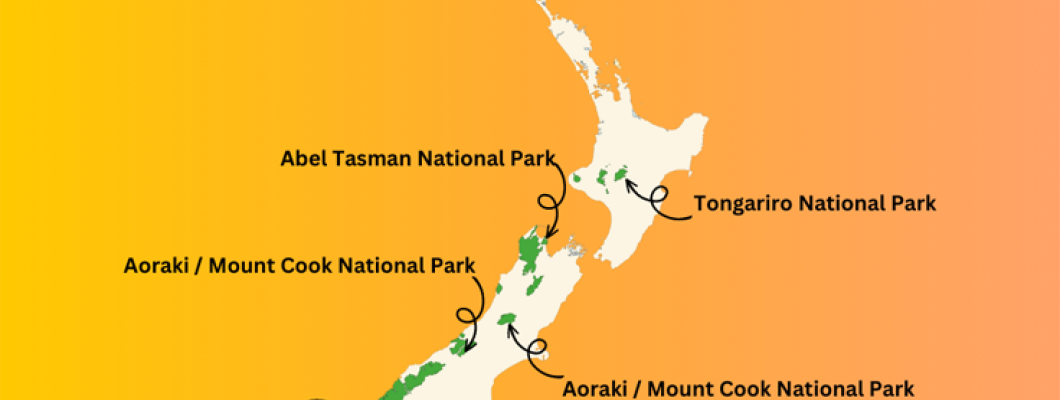
Introduction
New Zealand's national parks are a treasure trove of diverse landscapes, captivating wildlife, and boundless adventure opportunities. In this all-inclusive guide, we'll take you on a journey through some of the most breathtaking parks in the country, from the coastal paradise of Abel Tasman to the alpine wonderland of Aoraki Mount Cook. Experience the rugged beauty of Arthur's Pass, where dense rainforests meet soaring mountain peaks, and uncover the towering heights of Mount Cook National Park, home to the highest mountains and longest glaciers in the country.
Throughout this guide, you'll find key highlights, activities, and accommodations that make these national parks the ultimate destinations for nature lovers, adventure enthusiasts, and those seeking a serene escape. Whether you're a seasoned hiker, a mountain climber, or simply looking to enjoy the natural beauty of New Zealand, this comprehensive guide will provide insights into the best each park has to offer.
So, prepare to uncover the hidden gems, rich history, and unforgettable experiences that await in New Zealand's most stunning national parks. Embark on a journey of exploration, and let the wonders of these incredible landscapes captivate your senses and create lasting memories.
5 Must-Visit National Parks in New Zealand for Camping and Hiking Enthusiasts
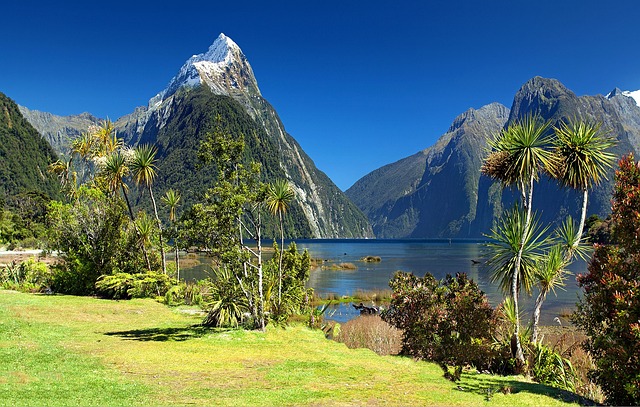
Fiordland National Park, situated on the South Island of New Zealand, is a breathtaking natural paradise that leaves visitors in awe of its spectacular fiords, dramatic waterfalls, and majestic snow-capped peaks. With ancient rainforests clinging to the mountains, cascading waterfalls, and pristine lakes set against a backdrop of granite peaks, it is no wonder that Rudyard Kipling once called this incredible place the 'Eighth Wonder of the World.' In this blog post, we will explore the key highlights, activities, and accommodation options that make Fiordland National Park a must-visit destination for nature lovers.
.jpg)
Key Highlights:
- A geological masterpiece: Fiordland National Park is home to 14 awe-inspiring fiords, created over 100,000 years by glaciers carving u-shaped valleys that were later flooded by the sea. The Maori people attribute the creation of these fiords to Tute Rakiwhanoa, a mythical giant stonemason who shaped the valleys with his adzes.
- Spectacular waterfalls: Fiordland's abundant rainfall results in countless breathtaking waterfalls, which tumble down the steep valley sides and into the fiords below.
- Milford Sound: Described by Kipling as the 'Eighth Wonder of the World,' Milford Sound is an iconic destination offering daily scenic flights and cruises that showcase its stunning beauty.
- Doubtful Sound: As New Zealand's deepest fiord at 421 meters, Doubtful Sound is a sanctuary for wildlife, including bottlenose dolphins, fur seals, and penguins.
- Pristine wilderness: Two-thirds of Fiordland National Park is covered in virgin beech and podocarp forest, offering visitors the chance to explore a primeval world through a 500-kilometer network of walking tracks.
- UNESCO World Heritage Site: In 1990, Fiordland was designated a United Nations World Heritage site and named Te Wahipounamu, meaning 'the place of greenstone,' in recognition of its treasured mineral resource.
Accommodation:
The Department of Conservation provides over 50 hikers' huts within the park, including comfortable 'Great Walks' huts along the Milford, Kepler, and Routeburn tracks. More basic accommodations are available on other tracks, typically featuring sleeping platforms with mattresses, toilet facilities, and a water supply. Lakeside townships of Te Anau and Manapouri offer a wide range of accommodation options, while a backpackers' lodge is available at Milford Sound, the only fiord accessible by road.
Key Activities:
- Great Walks and beyond: Fiordland National Park boasts three of New Zealand's 'Great Walks': the five-day Milford Track, the four-day Kepler Track, and the three-day Routeburn Track, which crosses into Mount Aspiring National Park. Many other lesser-known but equally stunning tracks are also available for exploration.
- Sea kayaking and diving: Fiordland's fiords and lakes offer unique opportunities for sea kayaking and diving, with the chance to observe deep-water sea plants, dolphins, fur seals, and penguins up close.
- Fiord cruises: Daily scenic flights and coach services bring visitors to Milford Sound for unforgettable scenic cruises, while eco-cruises of less accessible fiords can be arranged in Te Anau or Manapouri.
Key Tips:
- Book hut accommodation for the Great Walks in advance from late October to April.
- Be prepared for cold temperatures, snow, strong winds, and heavy rain at any time of the year.
- Don't forget insect repellent to ward off the legendary sandflies in Fiordland National Park.
- For those who are less experienced in outdoor activities, it is recommended to book a guided walk.
- Hunting and fishing are permitted within the park, but permits are required.
Final Thoughts on Fiordland National Park
Fiordland National Park is a true natural wonder that offers an unforgettable experience for travelers seeking adventure, pristine landscapes, and unique wildlife encounters. With its diverse range of activities, accommodations, and breathtaking scenery, there's no doubt that a visit to Fiordland National Park should be on every nature lover's bucket list.
Discover the Wonders of Tongariro National Park: A Journey through Nature, Culture, and Adventure
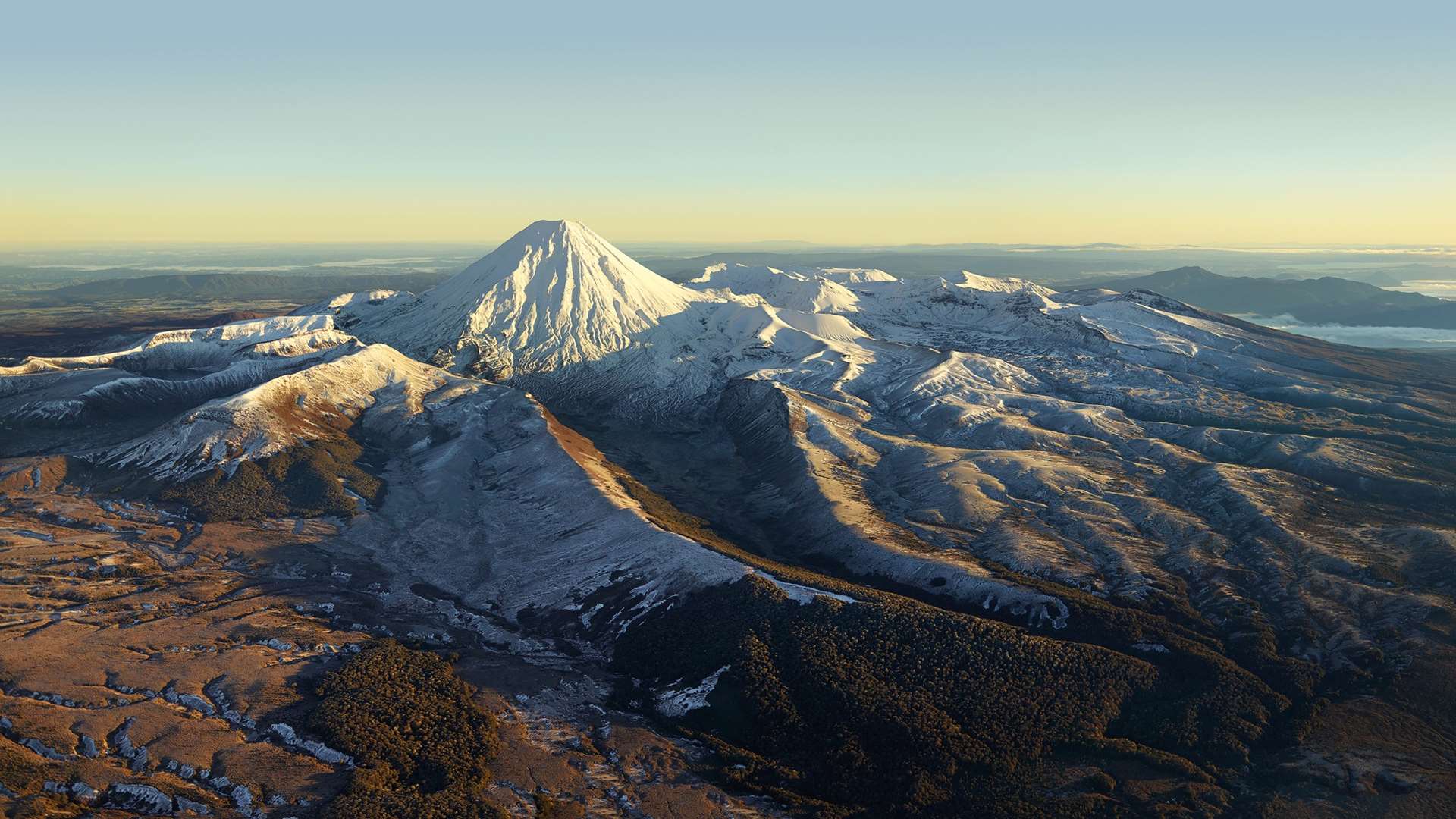
Nestled in the heart of New Zealand, Tongariro National Park proudly stands as the country's first national park, established in 1887. Recognized for both its cultural significance to the Māori people and its stunning natural features, the park has been awarded dual UNESCO World Heritage status. Spanning over 80,000 hectares, the park boasts an extraordinary display of volcanic wonders, including emerald lakes, old lava flows, steaming craters, colorful silica terraces, and peculiar alpine gardens. It is truly a landscape of mesmerizing beauty and diversity.
The Volcanic Heart of the Park:
Tongariro National Park is home to three remarkable volcanoes—Ruapehu, Ngauruhoe, and Tongariro—forming the southern limits of the Taupo Volcanic Zone, a part of the Pacific Ocean's 'Ring of Fire.' With volcanic activity dating back two million years and still ongoing today, these volcanoes offer a unique opportunity to witness the power of nature. Visitors are advised to check current volcanic activity before venturing into the park, with resources like GeoNet and the Department of Conservation providing essential information.

Activities for Everyone:
Tongariro National Park offers a diverse range of activities, catering to various interests, ages, and abilities
- Tongariro Alpine Crossing: This popular trek showcases the park's phenomenal volcanic scenery, along with stunning views of Lake Taupō and Mt Taranaki.
- Multiday Walks: Overnight hikes, such as the four-day Northern Circuit and the six-day Round the Mountain track, provide immersive experiences in the park's diverse landscapes.
- Nature Trails: A series of short nature trails introduce visitors to the park's unique flora and fauna, with Whakapapa Village serving as an ideal starting point.
- Waterfall-watching: Experience the park's dramatic waterfalls through short walks, including Taranaki Falls, Waitonga Falls, Silica Rapids, and Tawhai Falls.
- Skiing: Embrace the snow at Mt Ruapehu's ski areas—Whakapapa, Tūroa, and Tukino—for skiing, snowboarding, tobogganing, and tubing.
- New Zealand's Highest Café: Take a scenic gondola ride to Knoll Ridge at Whakapapa for super-scenic dining all year round.
- Lord of the Rings Film Sites: Visit the awe-inspiring locations that featured in Peter Jackson's Lord of The Rings trilogy, with Mt Ngauruhoe taking center stage.
Key Tips for Visitors:
- The park can be enjoyed throughout the year with proper clothing, equipment, and experience.
- Check the weather, volcanic activity, and track conditions at the Department of Conservation Visitor Centre before embarking on a walk.
- If you plan to overnight in a hikers' hut, fill in an intention form at the Visitor Centre.
- Remember to pack sunscreen and sunglasses for protection, regardless of the season.
- Be prepared for unpredictable weather conditions during your adventure.
Accommodation Options:
Tongariro National Park offers a variety of accommodations, ranging from hikers' huts on the Tongariro Northern Circuit to campsites, lodges, and motels in Whakapapa Village. Nearby towns like Tūrangi, National Park Village, Ohakune, Raetihi, and Taumarunui also provide diverse lodging options. It is recommended to book in advance during peak season (December to March). Embark on an unforgettable journey through Tongariro National Park, where nature, culture, and adventure come together in perfect harmony. Explore its diverse landscapes, learn about its rich cultural heritage, and create lasting memories in this remarkable corner of New Zealand.
Final Thoughts on Tongariro National Park
Tongariro National Park is a testament to the breathtaking beauty and rich cultural history of New Zealand. With its diverse range of activities and accommodations, the park is an ideal destination for all types of travelers, from outdoor enthusiasts to history buffs and families alike. As you explore the park's awe-inspiring landscapes and immerse yourself in the unique experiences it has to offer, you will undoubtedly come away with a deeper appreciation for the power and wonder of nature, as well as the enduring legacy of the Māori people.
Explore the Coastal Wonderland of Abel Tasman National Park

Immerse yourself in the stunning beauty of Abel Tasman National Park, a coastal paradise that offers visitors a unique combination of physical activities and relaxing beach life. Explore this breathtaking destination on foot, by cruise boat, sailing catamaran, water taxi, or sea kayak, and discover a world where sunbathing, swimming, and snorkeling complement exhilarating bursts of hiking and paddling.
For those seeking a luxurious experience, comfortable lodges await, but many visitors choose to sleep under the stars to fully capture the essence of Abel Tasman.
A Natural Haven of Beaches, Forests, and Wildlife
Abel Tasman National Park is a sanctuary of pristine sandy beaches, crystal-clear streams, and native forests regenerating on granite and marble headlands. At Te Puketea Bay, follow a walking track up to Pitt Head, an ancient Maori pa (fort) site. Marvel at the terracing and food pits while enjoying panoramic views that reveal why this location was chosen for its strategic advantage.
The native wildlife plays a vital role in the park's vibrant ecosystem. Listen to the melodic songs of tui and bellbirds echoing through the forests, and watch shags (cormorants), gannets, and little blue penguins diving for their meals. Observe fur seals lounging on the rocks surrounding Tonga Island, a vital part of this diverse coastal environment.
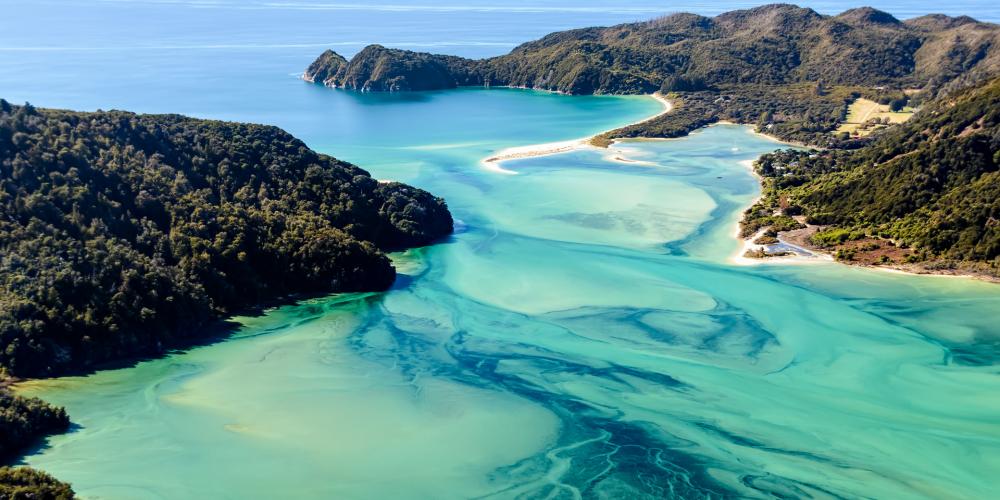
Access, Accommodation, and Activities
Access to the park is available from Marahau and Kaiteriteri in the south, and from Golden Bay and Totaranui in the north. Most water taxi services depart from Marahau or Kaiteriteri, operating up to Totaranui.
The Department of Conservation (DOC) provides 'Great Walk' hikers' huts along the Coastal Track and standard huts on the inland tracks. Campsites with water, toilets, and fireplaces are also available within the park. Bookings are required during peak season. Additional accommodation options can be found in nearby settlements.
Abel Tasman National Park offers a variety of activities, including the renowned 'Great Walk' – the Abel Tasman Coastal Track – which takes between 3 and 5 days to complete. Alternatively, explore the park's inland tracks that lead to the dramatic karst landscape of Takaka Hill. Guided sea kayaking tours and rentals are also available, allowing you to experience the park from a different perspective.
For day-trippers, water taxi companies can customize a mix of boat sightseeing and track walking, with pick-up or drop-off points along the tracks. Pre-booking is advised.
Helpful Tips for Your Visit
- Book Abel Tasman Coast Track huts and campsites in advance year-round.
- Obtain a Department of Conservation camp pass for campsites along the Coastal Track.
- Fishing is prohibited in the Tonga Island marine reserve between Bark Bay and Awaroa Head.
- Treat or boil water from sources other than Totaranui, Bark Bay, and the Anchorage.
- The sea is ideal for swimming between December and March.
- Limited water taxi services and guided group trips from Wainui to Totaranui offer a deeper wilderness experience for independent travelers.
- Check the latest information at the nearest DOC visitor center before your adventure.
Abel Tasman National Park promises an unforgettable experience where the wonders of nature, exhilarating outdoor activities, and serene relaxation come together to create a coastal haven that will captivate your senses and leave you with memories to cherish.
Discover the Alpine Wonderland of Arthur's Pass National Park
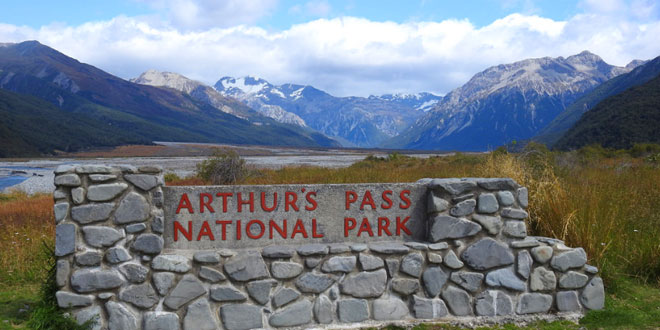
Arthur's Pass National Park, a majestic landscape nestled amidst the Southern Alps, offers a stunning contrast between the eastern side's vast beech forests and shingle-filled riverbeds and the western side's dense rainforests and deeply gorged rivers. This alpine paradise is a dream come true for nature enthusiasts and adventure seekers alike.
Embark on a Journey to Arthur's Pass
Visitors can experience the breathtaking beauty of Arthur's Pass National Park by road, traversing viaducts, bridges, rock shelters, and waterfalls that showcase the marvels of civil engineering. Alternatively, opt for the scenic TranzAlpine Train journey from Christchurch. This exciting adventure allows you to explore the park's native forests, indulge in delicious food at a cozy café, and observe the inquisitive kea – a native alpine parrot.
Discover the Park's Highlights
Arthur's Pass National Park boasts numerous peaks over 2,000 meters, with Mount Murchison standing tall at 2,400 meters. The park's valleys, shaped by glacial action, offer breathtaking views. As you venture higher into the sub-alpine shrublands, you'll be greeted by enchanting alpine fields adorned with vibrant wildflowers.
The quaint village at Arthur's Pass serves as an ideal starting point for various short walks. Don't miss the entrance to the historic Otira rail tunnel – an impressive 8.5-kilometer engineering feat through solid rock.
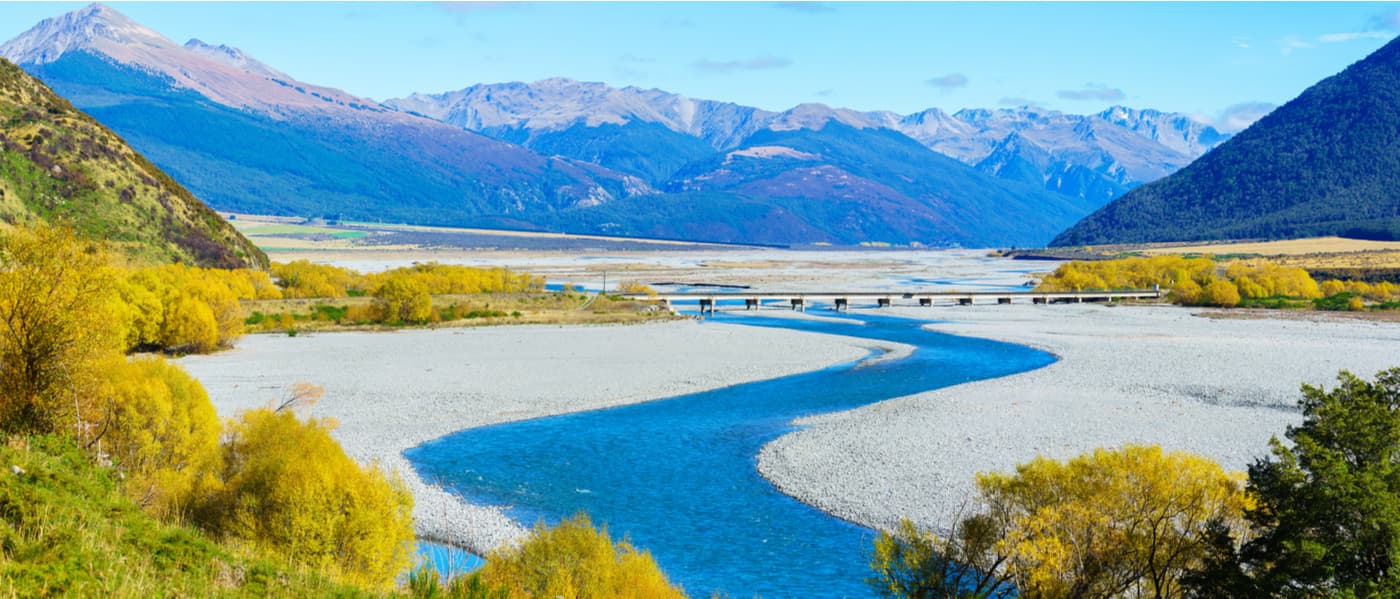
Rest and Relaxation in Arthur's Pass
The Department of Conservation provides 30 hikers' huts and basic shelters within the park, all connected by an excellent track system. For those seeking more comfortable accommodations, Arthur's Pass village offers a variety of options, from backpacker lodges to hotel rooms.
Experience the Best of Arthur's Pass National Park
Whether you're up for short strolls or full-day hikes, Arthur's Pass has something for everyone. The Devil's Punchbowl Falls, Bridal Veil Track, Historic Village Walk, Temple Basin, and the Dobson Nature Walk are among the popular short walks. More experienced hikers can tackle Cons Track, Avalanche Peak, Mount Aicken, and Mount Bealey. Keep an eye out for the park's most famous inhabitant – the kea, known for its playful and curious nature.
In the winter months, the Temple Basin Ski Area offers skiing and snowboarding for all levels. The park is also a mountaineering mecca, providing an array of classic climbing routes for ice climbers and rock climbers alike.
Prepare for Your Adventure
Before embarking on any walk or hike, inform someone responsible about your plans and expected return. Bring warm clothing, rainwear, sun protection, food, and drinks, as mountain weather can change rapidly. Remember not to feed the kea, as they can become dependent on human interaction and lose their ability to find food for themselves. As you explore the alpine wonderland of Arthur's Pass National Park, always stay informed about the latest conditions and facilities by checking with the nearest DOC visitor center.
Discover the Alpine Majesty of Aoraki Mount Cook National Park
Aoraki Mount Cook National Park, an awe-inspiring alpine wonderland, is home to the highest mountains and longest glaciers in New Zealand. With its towering peaks, permanent snowfields, and breathtaking glaciers, the park is truly a gem for nature lovers and adventure seekers.
The Legend of Aoraki
According to Ngāi Tahu legend, Aoraki and his three brothers were the sons of Rakinui, the Sky Father. When their canoe capsized on a reef, the brothers climbed on top, and the freezing south wind transformed them into stone. The canoe became the South Island (Te Waka o Aoraki), while Aoraki and his brothers turned into the peaks of the Southern Alps.
Experience the Accessible Alpine World
Aoraki Mount Cook National Park, featuring 23 peaks over 3,000 meters high, is highly accessible via State Highway 80. Aoraki/Mt Cook Village, located beside the picturesque Lake Pukaki, serves as an ideal base for alpine activities. The park forms the majority of New Zealand's only International Dark Sky Reserve, making it a prime spot for stargazing.
Mountain enthusiasts consider the park to be the best climbing region in Australasia, while casual adventurers can enjoy numerous mountain walks that lead to alpine tarns, herb fields, and incredible glacier views. Keep an eye out for the cheeky kea, a native mountain parrot.
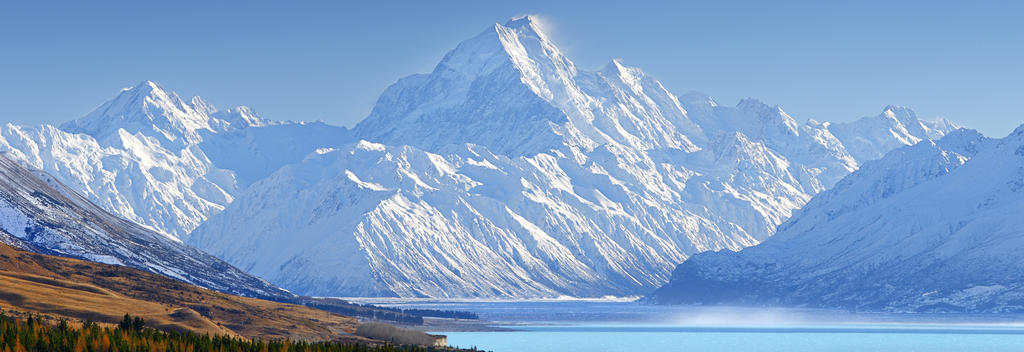
Explore the Mighty Tasman Glacier
The 27-kilometer-long Tasman Glacier is a powerful force of nature, carving the valley sides and providing a landing place for ski planes and helicopters. The park's surreal, milky lakes owe their opaque appearance to the suspended, glacier-ground rock sediment.
Comfortable Accommodations
The Department of Conservation maintains 17 huts in the park, most of which cater to mountaineers. Aoraki/Mt Cook Village offers a range of accommodation options, from backpacker lodges and campsites to luxury hotels. The Hermitage Hotel is renowned for its stunning views of Aoraki/Mt Cook, while Lake Oahu Lodge provides a more secluded experience.
The nearest towns, Twizel and Lake Tekapo offer various dining and accommodation options.
Engage in Thrilling Activities
Aoraki Mount Cook National Park features 10 short walks that begin near the village, including the Governors Bush Walk, Bowen Bush Walk, Blue Lakes and Tasman Glacier View Walk, and Glencoe Walk. For more experienced hikers, Mueller, Copland, and Ball passes present additional challenges.
Helicopters and ski planes offer access to the park's incredible glaciers, with the Tasman Glacier providing an excellent option for intermediate skiers. From October to May, visitors can explore the Tasman Glacier's terminal lake by boat.
Mountaineering enthusiasts can attempt to conquer Aoraki/Mount Cook or tackle other popular peaks like Tasman, Malte Brun, Elie de Beaumont, Sefton, and La Perouse.
Plan Your Adventure
Before climbing, complete a trip intentions form at the Department of Conservation Visitor Centre. Local guides are available for climbing, walking, and glacier skiing. Remember that winter climbing is an extreme sport, recommended only for well-prepared, experienced mountaineers. The park's airport serves domestic commercial flights and scenic flight operators. Be prepared for sudden weather changes, including heavy rainfall, snow, and high winds.
Conclusion
As we've explored the stunning landscapes of New Zealand's national parks, it's clear that this beautiful country offers an unmatched diversity of awe-inspiring natural wonders. From the sandy shores of Abel Tasman to the icy peaks of Aoraki Mount Cook, and the lush forests of Arthur's Pass to the towering heights of Mount Cook National Park, each destination presents its own unique charms and adventures for visitors to experience.
Whether you choose to embark on a challenging hike, glide through the water on a kayak, or simply relax and take in the breathtaking views, these national parks offer unforgettable experiences for everyone. The memories and connections made in these pristine environments will undoubtedly last a lifetime, leaving a deep appreciation for the natural beauty and rich history of New Zealand's incredible landscapes.
As you venture out to explore these national treasures, always remember to respect the land, its wildlife, and its cultural significance. By doing so, future generations can continue to enjoy and marvel at the wonders of New Zealand's national parks. Happy exploring!

Leave a Comment